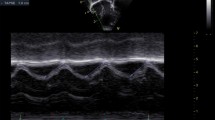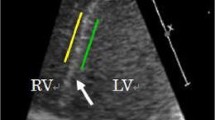Abstract
This study aims at documenting the changes in ventricular tissue velocities, longitudinal strain and electromechanical coupling during the first month of life. During the neonatal period, when the ventricular myocardium is not yet fully maturated, the heart is subjected to significant hemodynamic changes. We studied the ventricular performance of 16 healthy neonates at three time points over the first month of life: on days 2 (IQR [2;2]), 13 [12;14] and 27 [25;29]. We found that systolic and diastolic tissue velocities increased significantly in both left and right ventricle (by 1.2–1.7 times, p < 0.001). Congruently, we found that peak systolic longitudinal strain of the right and left ventricles increased significantly. However, no significant changes in longitudinal strain rate were observed. Finally, QS-intervals shortened during the neonatal period: being measured at 12 points throughout the left ventricle, time to peak systolic velocity decreased on average to 89 % in the second and to 80 % in the fourth week of life (22.3 ± 0.2 vs. 19.8 ± 0.3 vs. 17.8 ± 0.5 ms, r = −0.564, p < 0.001). When comparing opposing walls of the left ventricle, no dyssynchrony in left ventricular contraction was found. In addition to increasing systolic and diastolic tissue velocities during the first month of life, the time to peak systolic contraction shortens in the neonatal heart, which may reflect an increasing efficiency of the excitation–contraction coupling in the maturing myocardium. While there appears to be no dyssynchrony in ventricular contraction, these findings may extend our appreciation of the immature neonatal heart and certain disease states.



Similar content being viewed by others
Abbreviations
- Aw:
-
Peak atrial diastolic tissue velocity
- Ew:
-
Peak early diastolic tissue velocity
- IVS:
-
Interventricular septum
- LV:
-
Left ventricle
- RV:
-
Right ventricle
- S:
-
Strain
- SR:
-
Strain rate
- STE:
-
Speckle tracking echocardiography
- Sw:
-
Peak systolic tissue velocity
- TDI:
-
Tissue Doppler imaging
References
Akao M et al (2013) Developmental changes in left and right ventricular function evaluated with color tissue Doppler imaging and strain echocardiography. J Nippon Med Sch 80(4):260–267
Alp H et al (2012) Normal values of left and right ventricular function measured by M-mode, pulsed doppler and Doppler tissue imaging in healthy term neonates during a 1-year period. Early Hum Dev 88(11):853–859
Artman M et al (1988) Inotropic responses change during postnatal maturation in rabbit. Am J Physiol 255(2 Pt 2):H335–H342
Boettler P et al (2005) Heart rate effects on strain and strain rate in healthy children. J Am Soc Echocardiogr 18(11):1121–1130
Eidem BW et al (2004) Impact of cardiac growth on Doppler tissue imaging velocities: a study in healthy children. J Am Soc Echocardiogr 17(3):212–221
Ekici F et al (2007) Myocardial tissue velocities in neonates. Echocardiography 24(1):61–67
Elkiran O et al (2014) Tissue Doppler, strain, and strain rate measurements assessed by two-dimensional speckle-tracking echocardiography in healthy newborns and infants. Cardiol Young 24(2):201–211
Eriksen BH et al (2014) Myocardial function in term and preterm infants. Influence of heart size, gestational age and postnatal maturation. Early Hum Dev 90(7):359–364
Friedberg MK et al (2007) Mechanical dyssynchrony in children with systolic dysfunction secondary to cardiomyopathy: a Doppler tissue and vector velocity imaging study. J Am Soc Echocardiogr 20(6):756–763
Friedman WF (1972) The intrinsic physiologic properties of the developing heart. Prog Cardiovasc Dis 15(1):87–111
Galiuto L, Ignone G, DeMaria AN (1998) Contraction and relaxation velocities of the normal left ventricle using pulsed-wave tissue Doppler echocardiography. Am J Cardiol 81(5):609–614
Gombosova I et al (1998) Postnatal changes in contractile time parameters, calcium regulatory proteins, and phosphatases. Am J Physiol 274(6 Pt 2):H2123–H2132
Hamaguchi S et al (2013) Developmental changes in excitation–contraction mechanisms of the mouse ventricular myocardium as revealed by functional and confocal imaging analyses. J Pharmacol Sci 123(2):167–175
Hiarada K et al (2000) Tissue doppler imaging of left and right ventricles in normal children. Tohoku J Exp Med 191(1):21–29
Klitsie LM et al (2013) Longitudinal follow-up of ventricular performance in healthy neonates. Early Hum Dev 89(12):993–997
Klitzner T, Friedman WF (1988) Excitation–contraction coupling in developing mammalian myocardium: evidence from voltage clamp studies. Pediatr Res 23(4):428–432
Kozak-Barany A et al (2000) Efficiency of left ventricular diastolic function increases in healthy full-term infants during the first months of life. A prospective follow-up study. Early Hum Dev 57(1):49–59
Lewandowski AJ et al (2013) Preterm heart in adult life: cardiovascular magnetic resonance reveals distinct differences in left ventricular mass, geometry, and function. Circulation 127(2):197–206
Marijianowski MM et al (1994) The neonatal heart has a relatively high content of total collagen and type I collagen, a condition that may explain the less compliant state. J Am Coll Cardiol 23(5):1204–1208
Maylie JG (1982) Excitation–contraction coupling in neonatal and adult myocardium of cat. Am J Physiol 242(5):H834–H843
Mori K et al (2000) Left ventricular wall motion velocities in healthy children measured by pulsed wave Doppler tissue echocardiography: normal values and relation to age and heart rate. J Am Soc Echocardiogr 13(11):1002–1011
Mori K et al (2004) Pulsed wave Doppler tissue echocardiography assessment of the long axis function of the right and left ventricles during the early neonatal period. Heart 90(2):175–180
Nakanishi T et al (1987) Development of myocardial contractile system in the fetal rabbit. Pediatr Res 22(2):201–207
Notomi Y et al (2006) Maturational and adaptive modulation of left ventricular torsional biomechanics: Doppler tissue imaging observation from infancy to adulthood. Circulation 113(21):2534–2541
Rychik J, Tian ZY (1996) Quantitative assessment of myocardial tissue velocities in normal children with Doppler tissue imaging. Am J Cardiol 77(14):1254–1257
Sekii K et al (2012) Fetal myocardial tissue Doppler indices before birth physiologically change in proportion to body size adjusted for gestational age in low-risk term pregnancies. Early Hum Dev 88(7):517–523
Stopfkuchen H (1987) Changes of the cardiovascular system during the perinatal period. Eur J Pediatr 146(6):545–549
van der Hulst AE et al (2011) Tissue Doppler imaging in the left ventricle and right ventricle in healthy children: normal age-related peak systolic velocities, timings, and time differences. Eur J Echocardiogr 12(12):953–960
Acknowledgments
The authors thank the following institutions for providing scholarships for the research visits to the All India Institute of Medical Sciences: “Stiftung der Deutschen Wirtschaft” (Foundation of the German Business, to M.K.K.) and “Cusanuswerk” (to P.C.K.).
Author Contributions
All authors have contributed significantly to this manuscript: analysis and interpretation of data, drafting and revision of the manuscript (M.K.K., P.C.K., S.R.), acquisition, analysis and interpretation of the data (H.D.), revision of the manuscript and making significant intellectual additions to the manuscript (R.A., S.S.K, A.S.).
Author information
Authors and Affiliations
Corresponding author
Ethics declarations
Conflicts of interest
Nothing to declare.
Additional information
Peter C. Kahr and Maike K. Kahr have contributed equally to the work.
Rights and permissions
About this article
Cite this article
Kahr, P.C., Kahr, M.K., Dabral, H. et al. Changes in Myocardial Contractility and Electromechanical Interval During the First Month of Life in Healthy Neonates. Pediatr Cardiol 37, 409–418 (2016). https://doi.org/10.1007/s00246-015-1292-4
Received:
Accepted:
Published:
Issue Date:
DOI: https://doi.org/10.1007/s00246-015-1292-4




